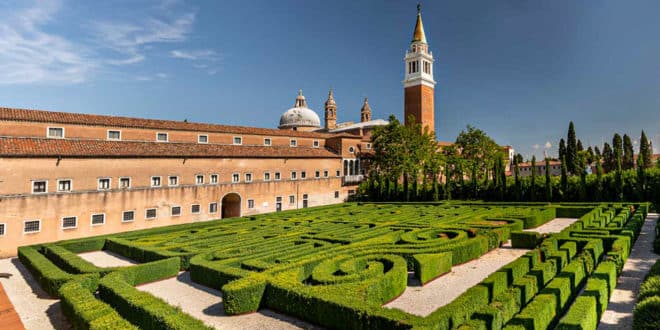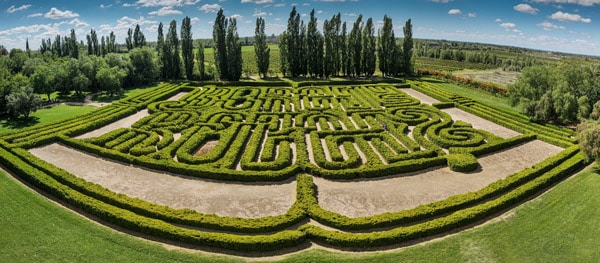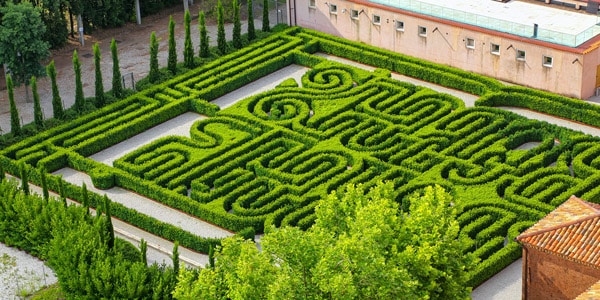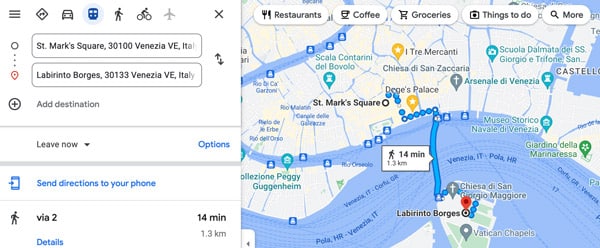Borges Labyrinth is located in the Laguna di Venezia on the island of San Giorgio Maggiore, in the center of the monastery of the same name (Monastero di San Giorgio Maggiore).
The modern landmark of Venice is a green landscape masterpiece full of spiritual meaning. It was recognized as one of the 10 wonders chosen by an authoritative committee in the competition for the most beautiful park in Italy.
The Green Labyrinth was created in 2011 in honor of the Argentine writer Jorge Luis Borges on the 25th anniversary of his death. The Fondazione Giorgio Cini financed the project with the help of the Jorge Luis Borges Foundation, founded by the writer’s widow Maria Kodama.
Page Contents
The idea of creation
The idea of creating an unusual hedge maze was inspired by Borges’s story “The Garden of Diverging Paths” (1941). This literary work is imbued with a philosophical sense of the infinity of time, where the lines of the past converge into a single future.
The author of the original monument to the work of Borges was Randall Coet, a British diplomat and architect fascinated by the theme of labyrinths. The project was conceived by him in 1979 and was preceded by events.
Randall Coet met Jorge Luis Borges back in the 1950s in Buenos Aires and was fascinated by his talent. Later he would write a letter to their mutual friend, the Argentine writer Susana Bombal, in which he recounted his dream. In it, he allegedly discussed with Borges that the best monument for him would be a labyrinth, as its theme runs through many of the author’s works.
After Susana Bombal’s death, this letter was found by her nephew Camilo Aldao, who commissioned the architect Randall Koet to create an unusual landscape project for the garden. The first El Laberinto de Borges labyrinth was created in 2003 on the Bombal family’s estate in the Argentine town of San Rafael in Mendoza province.
Description
The Italian version of Borges’ Labyrinth mirrors a project previously done in Argentina but on a slightly smaller scale. Why did the choice fall on Venice? The initiative to choose the location came from Maria Kodama. She knew that her husband was in love with the city, which he imagined as one big and beautiful labyrinth of canals and narrow streets, legends, and real events.
The green pattern is formed by more than 3,000 boxwood bushes about 90 cm high. Like all such structures, the labyrinth has only one exit, which creates intrigue and excitement in the soul of those who ventures down this intricate path. The total length of the paths between the emerald boxwood bushes is about 1 kilometer, and the walk time – is no more than 45 minutes if you do not get lost. However, do not worry because the low height of the bushes allows you to view the entire courtyard of the monastery and admire the views of its magical labyrinth garden.
The pleasant impression of the tour along the winding path can be increased by taking an audio guide with the original soundtrack “Walking through the labyrinth”. The music was written especially for this place by Antonio Fresa and performed by the orchestra of the Teatro La Fenice.
The labyrinth space is often used for interesting audiovisual, choreographic, and musical productions and performances.
Pattern
The green pattern of the plant labyrinth is not just a chaotic pattern. Instead, it resembles the shape of an open book in which Borges’ name is inscribed twice, as if in a mirror image. The ornament includes the numbers of his age of death (86 years), the image of a cane, an hourglass, question marks, and infinity signs, as well as the initials of the writer’s wife, Maria Kodama.
You can see and examine the encrypted letters and symbols of Borges’ Labyrinth from the top of the Campanile San Giorgio, which also offers a magnificent view of the cityscape of Venice.
Tickets and opening times
On weekdays, the Borges Labyrinth can only be visited as part of a group by making a reservation in advance. Start times are 10:00 and 14:00, and the duration of the visit is 45 minutes. The ticket for an adult costs 15 euros, for young people from 15 to 26 years and visitors over 65 years – 13 euros; for children from 6 to 14 years – 5 euros; and for children under 5 years are free.
I advise you to book tickets only on trusted sites getyourguide.com and tickets.com. If there are no tickets for the desired date, you can see an extended version of the tour, which is mentioned at the end of the article.
How to get to the island of San Giorgio Maggiore?
The island of San Giorgio is opposite Piazza San Marco and is perfectly visible from there.
You can reach the island of San Giorgio only by water. At the stop S. Marco-San Zaccaria “E” stop, take the N2 Vaporetto and get off at the S. Giorgio.
What else can I see in San Giorgio Maggiore?
The island of San Giorgio Maggiore is primarily known for the Basilica of San Giorgio Maggiore, designed by architect Andrea Palladio in the 16th century.
Other sights on the island are rarely included in one-day tourist itineraries. However, the small island, just 400 meters from the crowded Piazza San Marco, is an oasis of peace and quiet where you can spend your time and see the sights.
Since 1951 the Fondazione Giorgio Cini has put a lot of money into restoring the buildings of the monastery and the surrounding countryside, making it a lively cultural center.
The Baldassare Staircase is an unforgettable experience:
- The Baldassarre Longhena staircase was built-in 1643 as a grand entrance to the monastery.
- The Abbey Refectory of Andrea Palladio where on the back wall, we can admire a huge painting of the “Marriage of Cana” by Paolo Veronese. In 1797, during the French occupation of Venice, the original, cut into several parts, was taken to the Louvre, where it remains today.
- The historic Library of the Giorgio Cini Foundation is one of the largest and most valuable in Italy.
The Green Theater (Teatro Verde) in the southern part of the island is a modern amphitheater with an arena surrounded by beautiful nature. Actress Audrey Hepburn considered it the most beautiful open-air theater in the world. - For those who want to see as much as possible and save money, I recommend buying a comprehensive tour in advance, accompanied by an audio guide playing original music by composer Antonio Fres. The tour lasts 2.5 hours, starting at 10:00, 11:00, 13:00, or 14:00.
 Italy for me From Italy with love
Italy for me From Italy with love





